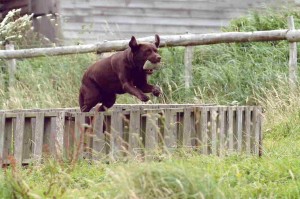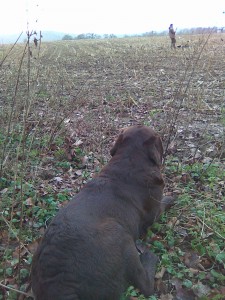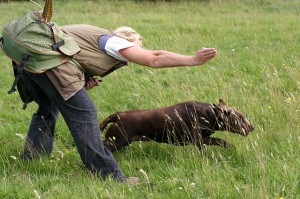‘The Future is Bright for the Chocolate Labrador’
Countrymans Weekly – 2nd Sept 09′
This article was written in response to an article a few weeks before with the catchline ‘ Chocolate Labradors are no Good in the Field’…… I simply HAD to repond 😉
——————————————————-
After Alf Woods article ‘Chocolate Labradors are no good in the field’ had been mentioned to me by several people with a note of caution in their voices, I opened the July 25th issue of ‘Countryman’s Weekly’ with a sense of trepidation. However, upon finishing the article, I actually thought it balanced, fair and entirely realistic in very many ways.
I entirely agree that chocolates almost without exception, up till extremely recent times, were made up of show and pet pedigrees, usually immediately handicapping them for natural working ability. However, In recent years, some kennels have started to inject trial lines into their chocolates by way of careful matings. The race for the first chocolate field trial champion is on, with the hugely encouraging trial successes of Jed Leeson’s Chocolate Styleside dogs, and Dorothy Walls Duffin’s Grangemead kennel amongst a handful of others.
I have, personally, been working chocolates, and mostly showbred chocolates at that, in the field for the last 15 years. Summers have also been spent running them in working tests and in the last couple of years we have stepped into trialing. I have a variety of dogs and bitches, some chocolate, some black carrying chocolate, who have Open test awards, Intermediate test wins, Novice wins and trial runs between them and, of course, they all are shot over all winter. For my sins they also mostly all have championship show awards, including recently, a Reserve CC. Without a trace of a ‘boast’ I can say, however, I know this is highly unusual. So is the chocolate REALLY the special needs child of the Labrador world?
The fundamental thing that often gets chocolate Labradors a bad name is the experience and ability of the people who tend to choose to work them. After all, lets be honest, very few people wake up and think “I want a really top class working dog…… I think I’ll go buy a showbred chocolate!” So the vast majority of those who DO work or train them, bought the puppy, and more importantly, RAISED that puppy as a pet dog. Then at some point thought, ‘I fancy working this dog…’ and so start training, often at 1 or 2 years old, with clubs or trainers, or worst of all, at home in their own inexperienced way. The result is exactly what would happen if that dog had a black or yellow coat. It is a pet dog in newcomer hands and the result is often, not very pretty.

His second dog, now he has the working bug, is almost always a ‘specialist’. A trial bred dog from a working kennel, usually black or yellow. He is a better handler by now and knows how to raise a puppy with work in mind, and, hey presto! the whole picture becomes prettier and the ‘chocolates can’t work’ stereotype is reinforced just that little bit more. Had his second dog also been a chocolate would it have ‘gone better’? – almost certainly. Did its colour handicap it, or infact did the handler and its start in life to a greater extent? Without a doubt.
Only a fool would not admit that a showbred dog ‘tends’ to have an upper ceiling of ability in almost any hands. I personally have found the showbred dog, even in reasonably experienced hands, starts to flounder a little at the higher end of the Open test or Novice trial scale when style, real drive, and natural problem-solving starts to need to come strongly into play. Up to this level, for me, they have never greatly set themselves apart from their working bred compatriots. They often ‘go’ slightly differently, and that can grate on ‘fast-dog’ handlers, but unfortunately, how many chocolates are IN experienced hands?….. very very few.
Its important to remember, the mad, lunging, whining, panting chocolate is just a dog with bad manners and a lack of basic training and boundaries. It could have been any colour. Showbred dogs tend to be bred to have confident, sociable, outgoing temperaments. A huge bonus if raised well, but a huge drawback if not. The quiet sensitivity of many of the working lines makes their confident showbred cousins look like mindless ‘act first, think later’ idiots. But that can be channeled into a really happy, buzzy, keen to please worker if tailored correctly, it does not HAVE to be a drawback.

The other important factor which is leaving many showbred dogs behind (not just chocolates) is the way they are trained. The showbred dog, undoubtedly, usually does not have the drive and pace of the working bred dog and, therefore in the early stages, needs training accordingly. You really wouldn’t expect to drive a Discovery they way you would drive a Ferrari, yet the two polar opposite bred dogs are almost always trained using the same methods. Understandably because the showbred dog at gundog classes tends to be very much a minority. Standard novice gundog training, in most quarters, especially at club level, involves a large amount of steadiness. Dummies thrown over the head. Pick dummies by hand. ‘Stay, Stay, Stay, Stay…’ Sadly, for a showbred dog, not exactly spilling over with natural desire, this approach tends to be utterly un-stimulating and entirely boring. They need what drive and desire they do have, encouraged from day one with very upbeat, short sharp training sessions, keeping them bouncing and leaving them wanting.
I think sometimes it is a very misunderstood area, regarding the breed standard, showing and the Labrador. The Labrador breed standard was drawn up by shooting men for shooting dogs. Very little has been changed over the years. The Labrador was a Light to Middleweight hunter type of a dog, not a Cob and not a racing thoroughbred. These extremes have come about by individual breeder’s interpretations of the breed standard and neither end of the spectrum look like the dogs intended by the original BS writers. Just being lean does not mean a dog is healthy. Just being heavier of build does not mean a dog is unhealthy. Carrying too much weight for its own structure makes a dog unhealthy and that can be seen, not only in the show-ring, but as often in the working type in a thousand pet homes every day. The idea, for example that working bred Labradors have a better record of joint health, hip and elbow results etc does not play out at all. Infact there are good and bad in every body shape of the breed.
There are as few chocolate Labradors shown in the ring as there are worked you may be surprised to know. The number in your average show class would be proportionate to the number in your average, say, working test field. One, maybe two, usually no more. We have not ‘given the Chocolate Labrador to the show ring’, we have, infact, ‘given the Chocolate Labrador to the pet owner’. However, there are a dedicated few working to wrestle it back from them!

The future really is far brighter than the past for the colour in terms of being taken seriously. There ARE some good chocolate role models, albeit very few, and all with a good dollop of working blood in them. There are some good stud dogs with proven ability now out there, and more importantly, they are not ONLY now being worked by pet owners and newcomers. So, hopefully, we can move towards giving them a helping hand to prove they aren’t the classroom idiot of the breed.
Diana Stevens
Wylanbriar Labradors
www.wylanbriar.com